
Serge Poliakoff (1906-1969)
Composition abstraite
Lot 628. Serge Poliakoff (Russia/France 1906‑1969). Composition abstraite. Signed Serge Poliakoff. Oil on canvas, 72.5 x 59.5 cm.
Executed in 1967.
The authenticity of this work has kindly been confirmed by Alexis Poliakoff. It is registered in the Serge Poliakoff Archives under number 967068.
Estimate
SEK 1.800.000 – 2.000.000
€ 174.000 – 193.000
Provenance
Bertil Nordenhake, Galerie Nordenhake, Broby.
A Swedish Private Collection, acquired by the present owner from the above.
In context:
Born in Moscow on the 8th of January 1900, the Russian painter Serge Poliakoff became one of the most important abstract painters of postwar Europe. After fleeing revolutionary Russia in 1917, Poliakoff made a short stop in Constantinopel before arriving in Paris in 1923. While earning his living as a musician, Serge’s interest in the art of painting grew and in 1929 he enrolled in both Académie Forchot and Académie de la Grande Chaumière. During his first period in the French capital, Poliakoff’s work were mainly focused on classic academic subjects such as nudes, nature and horses. However this came to change in 1935 when Serge Poliakoff again moved, this time to London where he continued his studies at the Slade School of Fine Art. From now on the abstract side of art and the layering of paint became a subject of interest for the 35-year old Poliakoff.
A few years later he once again set sail for Paris. Poliakoff’s second spell in Paris came to be a period of immerse studies in the art of colourful abstract painting. A great source of inspiration was his new acquaintance and fellow countryman Wassily Kandinsky. Further inspiration was drawn from the artist couple of Sonia and Robert Delaunay as well as the sculptor Otto Freundlich, all working with abstract colourful art. Poliakoff’s work now developed in a way where he let colour itself form the context of the painting and like all abstract painters Poliakoff became concerned with the relationships between line and surface, form and content, colour and light. During the late 1940’s Poliakoff also developed his very special way of abstract painting, arranging different fields of colour alongside one another and he came to be a front figure for the École de Paris.
Poliakoffs early post-war work is often characterized by his use of earthy colours such as shades of brown and grey. However, in the late 1940’s and 1950’s the palette changed and became brighter and more contrasting. The painting included in this sale is a colourful composition composed by fields in different shades of blue, red, yellow, white and black. These characteristic interlocking jigsaw arrangements was a style he returned to several times during the late 1950’s and 1960’s. Poliakoff himself declared, “The painting should be monumental, that is to say larger than its dimensions,” in his Cahier 1 of 1965. ”Composition abstraite” in this sale was executed in 1967, proving a vivid example of his later compositions painted in strong and light colours. The space, proportions and rhythm were the key elements in Poliakoff’s oeuvre and the gaze of the viewer is immediately drawn towards the centre of the canvas due to the increasing density of forms and colours. His fields of colours are surrounded by contours, always slightly blurred as in the painting included in this auction, giving a vibrating impression and almost optical illusion. The importance of vibration was expressed by Poliakoff in 1952 when he laid eyes on Malevich’s famous ”White square on white background”; ”He demonstrated to me once again the vital role of the vibration of the material. Even if there is no color, a painting where the material vibrates remains alive.”
Serge Poliakoff is regarded as one of the foremost artists of the 20th century and has influenced the western art scene to a great extent. During his lifetime, he was praised by the most influential abstract art historians and played a major part in the post-war debates on abstraction. His celebrated works are held in the collections of The Museum of Modern Art in New York, the Tate Gallery in London, the Malmö konsthall in Sweden and the Hirshhorn Museum and Sculpture Garden in Washington D.C. among others, as well as in many prominent private collections worldwide.